Those of you who read my previous post entitled resolution salamandering know, I committed to redoubling my efforts this year to picking up some of the salamander species that have managed to elude me these past couple years. So when a buddy of mine Brian (insituexsitu's Photos | SmugMug) asked if I was interested in a February north-coast trip, I jumped on it. As you also know unless you’ve been living under a rock this year - or to put it another way - especially if you’ve been living under a rock, California has been incredibly dry in 2012. Not a great time to be hunting gummies, but instead of writing off 2012 as lost, I decided to double down instead.
Traditionally, these trips have been less than focused. We would drive to areas, typically parks and the like, flip whatever and find little. This time was going to be different. I was tactical. I spoke to a number of people, sifted through databases, and most importantly received some very sage information from a former local, Michael Spencer. All of this led to the most successful amphibian trip I’ve ever taken.
On Friday morning, Brian and I met up at my office, loaded up my truck and hit the road. After a couple of short hours, we made it to southern Mendocino County. “Mendo” and I’ve come to refer to it, has always had a special place in my heart. Going back to 2003, I went on my first organized herping trip. Ever since, it has maintained mythical status in my physche. And on this day, It would pay dividends.
Our first spot was not what I would initially think of as diverse, but I was assured that this super-fantastic wonderland is awesome. On an otherwise dry stream-bank, some rock, a few boards and some AC yielded little. A little further closer to the stream on a slope with little shade, Brian flipped a long, thin board - under which was completely dry soil and a totally SICK adult spotted Black Salamander (Aneides flavipunctatus).
This is usually where I would put up two or three photos of this awesome animal, so what’s different in this case? Glad you asked.... As Brian was photographing the animal, a brief lunge sent it off the rock and down a hole where extraction was rendered impossible. I was really looking forward to photographing it also. Normally I’d be quite upset, however I was consoled by the fact that Brian was unable to get any decent shots of the animal either.
Besides, I was off finding a much cooler animal. A little further down the bank where a surface seep met the stream, I flipped a rock to find a uniquely colored and gorgeous frog.
Foothill Yellow-legged Frog (Rana boylii)

Foothill Yellow-legged Frog (Rana boylii) by Rob Schell Photography, on Flickr
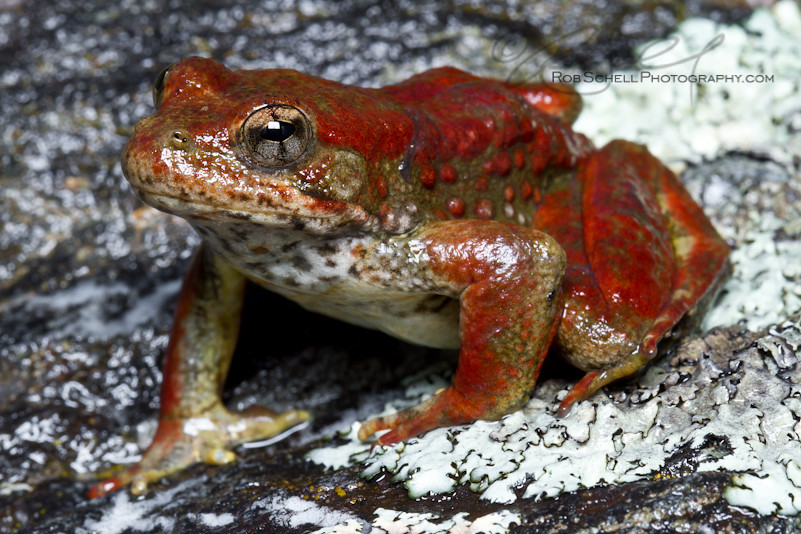
Foothill yellow legged frog (Rana boylii) by Rob Schell Photography, on Flickr

Foothill yellow legged frog (Rana boylii) by Rob Schell Photography, on Flickr
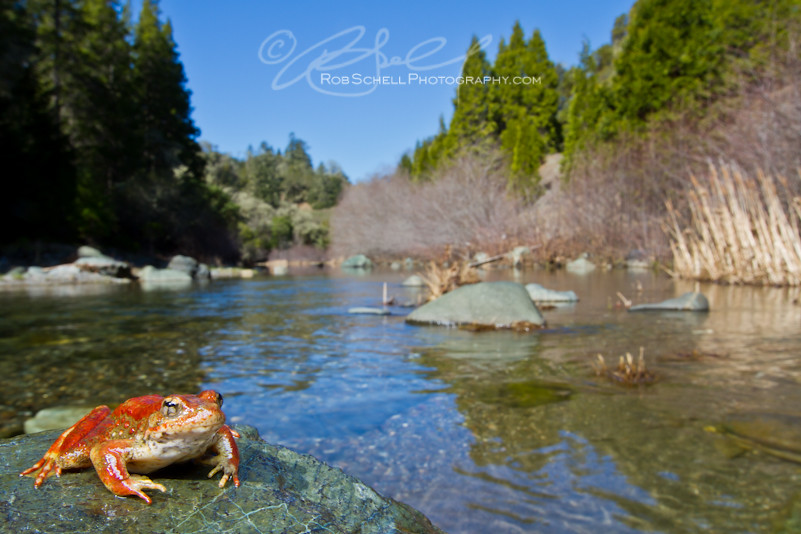
Foothill yellow legged frog (Rana boylii) by Rob Schell Photography, on Flickr
We left this spot and proceeded down the road to a local watering hole to toast our good fortunes. This would surely be an epic trip.
We headed further west towards the coast - arriving in the late afternoon. We set out to increase our species count and because of a couple of hot-tips we’d received, we quickly would. Our first flip netted us four individuals of three species including the first of our target species. A bit more poking around netted us several more of the same species.
Wandering Salamander (Aneides vagrans)
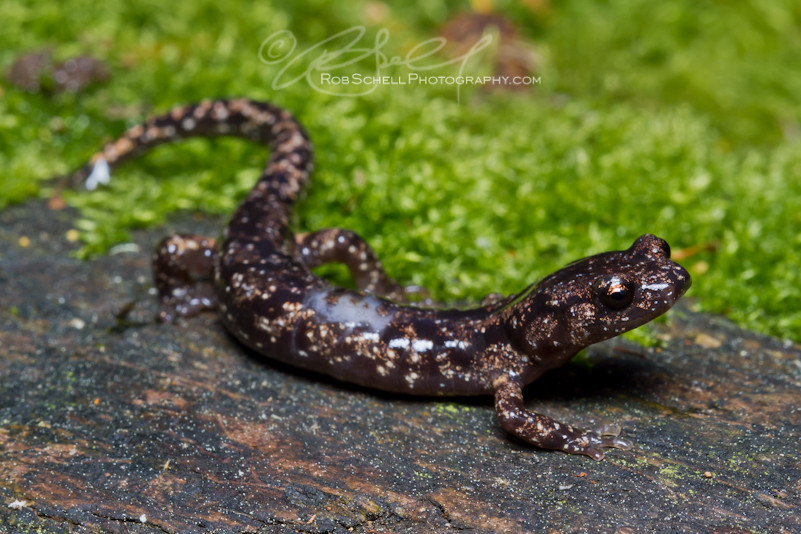
Wandering Salamander (Aneides vagrans) by Rob Schell Photography, on Flickr
This subadult had an old, but significant dorsal scar. It has been suggested that it’s likely a combative scar from another individual Aneides - I tend to agree.
Additionally we found two Northwestern Salamanders:
Adult Ambystoma gracile
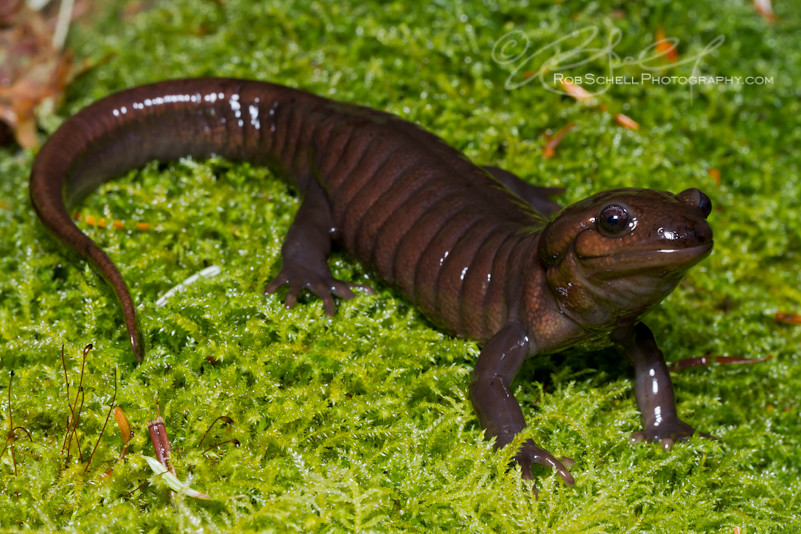
Northwestern Salamander (Ambystoma gracile) by Rob Schell Photography, on Flickr
Subadult Ambystoma gracile

Northwestern Salamander (Ambystoma gracile) by Rob Schell Photography, on Flickr
Lastly were one subadult and three adult Oregon Ensatina - we found about 25 more Ensatina on this day, but I only vouchered one - we had more important quarry to find.
Adult Ensatina eschscholtzii oregonensis

Oregon Ensatina (Ensatina eschscholtzii oregonensis) by Rob Schell Photography, on Flickr
After photographing these animals over the next hour or so, we set out to see what else we could find. A short time later we flipped a couple of juvenile Red-bellied Newts (Taricha rivularis). It seems like the defining characteristic of all Taricha species is their absolute and uncompromising ability to sit still. As such, I’ve completely lost my taste for spending any time to actually photograph these species beyond voucher shots - so I apologize to those newt-lovers among you - I won’t be posting any here.
As the sun began setting we hit the trail to scout a route for a night hike. We were of course compelled to flip along the way. Before the daylight gave out, we had one more species in the bag, literally. We bagged the critter to shoot the next day and headed off to dinner. We returned after dark and as the rain began to fall. We were hoping to hike down a Pacific Giant, or Northern Red-legged Frog, we even checked out a cascading stream for tailed frog, but after one, two, and three strikes, we were just two dudes out in the woods hiking in the rain. Little did I expect a home-run on the return trip.
We were getting close to the trail-head where we had flipped most of the cover earlier in the evening. We stopped to check out a downed redwood tree next to the trail which resulted in what was my favorite animal of trip. We bagged the animal to shoot it in more favorable light the next morning.
I apologize for so many photos of this individual, but it was one of the most fun photo shoots I’ve ever done. The animal was charismatic, and every pose was attractive through my lens. Moreover the animal itself, beyond being gorgeous, was totally chill, and whenever I’d pick it up it would use it’s prehensile tail to hold onto my finger. Every once in a rare while there are those shoots that everything comes together - this was one of those.
Wandering Salamander (Aneides vagrans)

Wandering Salamander (Aneides vagrans) by Rob Schell Photography, on Flickr
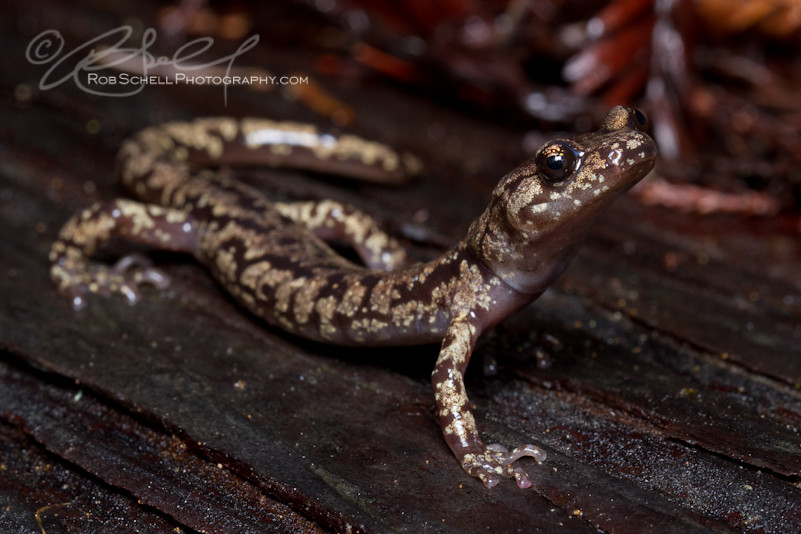
Wandering Salamander (Aneides vagrans) by Rob Schell Photography, on Flickr

Wandering Salamander (Aneides vagrans) by Rob Schell Photography, on Flickr
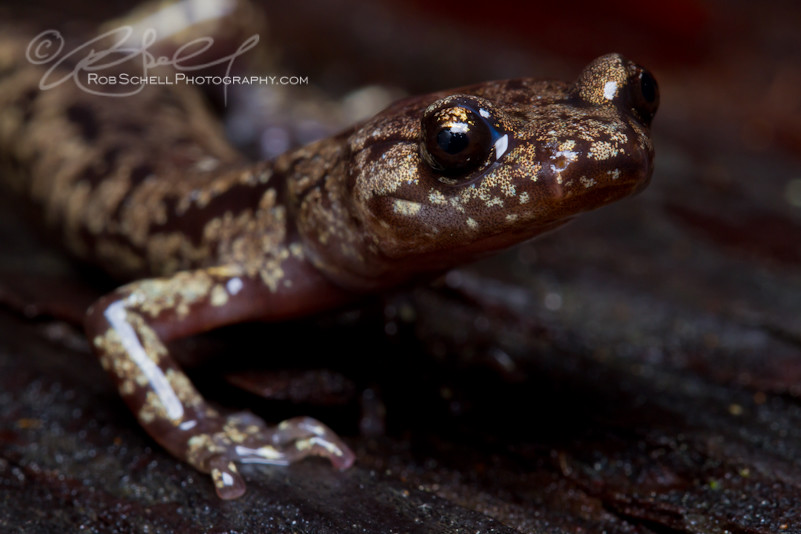
Wandering Salamander (Aneides vagrans) by Rob Schell Photography, on Flickr

Wandering Salamander (Aneides vagrans) by Rob Schell Photography, on Flickr
Since this post is as much about the photography as it is about the animals, I should go a bit into the gear. As some of you that follow my threads closely know, I have been trying out a new flash configuration. This was also the inaugural trip to try out some Graslon flash modifiers that were highly recommended by Owen Holt. Although they do a wonderful job of softening the light, they also take a lot of punch away from the flash. So I had to stop down both my shutter speed and up my ISO to 200 (something I usually hate doing) in order to get proper exposure. Even with all that, I still had to do some brightening in post. I suppose I probably did myself some disservice shooting this on the dark redwood bark, but under the canopy, the choices are rock, redwood, or moss.
Brian and I swapped animals and I took on the other find from the previous night. This critter was slightly less cooperative, but was compliant when it ultimately mattered.
Southern Torrent Salamander (Rhyacotriton variegatus)
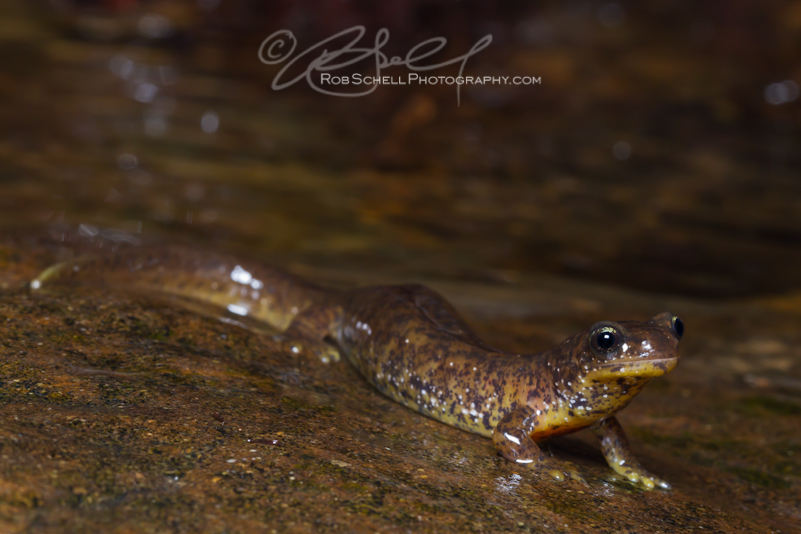
Southern Torrent Salamander (Rhyacotriton variegatus) by Rob Schell Photography, on Flickr
This next shot, I set up for a long-exposure. I took several variations - some with fill flash, others without. Exposures from 1 second to 20. I think this one is the best compromise - a 6 second exposure with fill flash.

Rhyachotriton.variegatus.02 by Rob Schell Photography, on Flickr
Short of pulling a Pacific Giant or Tailed frog out of out hat, we decided to pack up and push further north. It took us most of the day to get up the very northwestern corner of the state. We stopped at one spot along the way and turned up a couple of solid animals, because of the dropping mercury, we bagged the animals and headed to the hotel. On the way, I found a unique rock, that I was able to procure for the photoshoot (I returned it once I was through). I mainly wanted to see how they would turn out - it’s definitely lends a different feel to the shots - for better or worse. What are your thoughts?
Painted Salamander (Ensatina eschscholtzii picta)
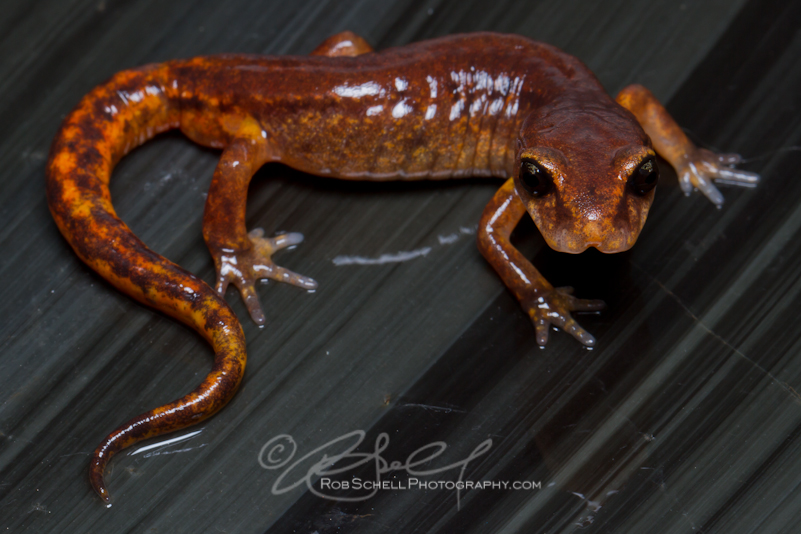
Painted Ensatina (Ensatina eschescholtzii picta) by Rob Schell Photography, on Flickr
Del Norte Salamander (Plethodon elongatus)

Del Norte Salamander (Plethodon elongatus) by Rob Schell Photography, on Flickr
The next morning, we returned our subjects and began to check out some habitat. A few miles up a logging road, we found some promising traits. We headed out and began flipping. After a short while, we came to a clearing, within that clearing, there were several downed redwood logs and logging spoils pile. Within several minutes, we managed to find another one of our targets. It was a large, and colorful individual, however it had a nipped tail that was beginning to regrow - which made it a bit odd to photograph. I didn’t spend quite so much time with this individual and regret it, but I managed to get a couple of shots that I’m quite happy with:
Clouded Salamander (Aneides ferreus)

Clouded Salamander (Aneides ferreus) by Rob Schell Photography, on Flickr
What do you guys think of this one? Does it work or miss the mark?

Clouded Salamander (Aneides ferreus) by Rob Schell Photography, on Flickr
At this location, we also flipped the most gorgeous Painted Salamander I’ve ever seen:
Ensatina eschscholtzii picta

Painted Ensatina (Ensatina eschescholtzii picta) by Rob Schell Photography, on Flickr
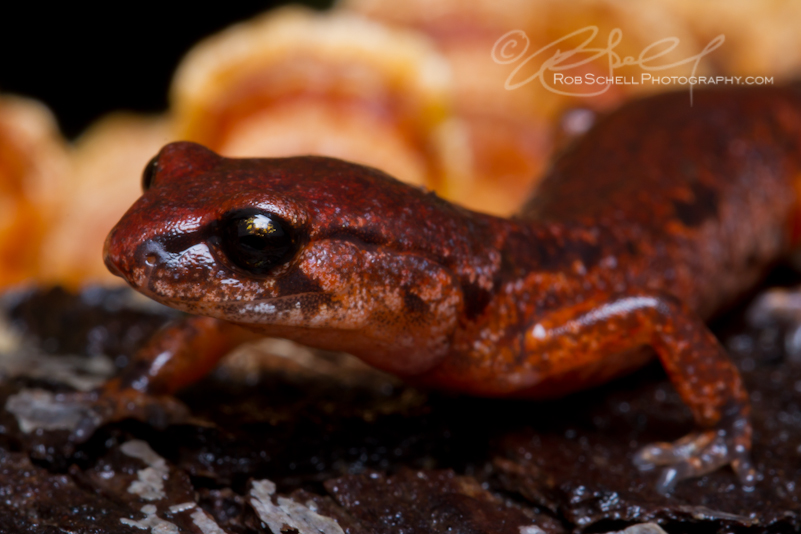
Painted Ensatina (Ensatina eschescholtzii picta) by Rob Schell Photography, on Flickr
With those two finds, we headed a bit further south, stopping at some drive-by sites to spot check for Black Salamanders.
We turned up a few more Torrent and juvenile Del Norte Salamanders, and even flipped this Subadult Northwestern under some leaf litter - that was pretty damn cool.
Ambystoma gracile

Northwestern Salamander (Ambystoma gracile) by Rob Schell Photography, on Flickr
The day was wearing on, so we stopped at one last place. Fortunately for us, that place was superbly productive. I flipped yet another juvie Del Norte Salamander - this was was another high-red colored individual, so I had to grab a couple of shots:

Del Norte Salamander (Plethodon elongatus) by Rob Schell Photography, on Flickr
While I was doing so, Brian flipped a very cool juvie Black Salamander - Just look at it!! It also meant we were in the right place. A short time later, Brian had an epic flip - undoubtedly the parents of said juvie. Adult male and female frosted phase Blacks. You can’t do any better than that!
Mother Aneides flavipunctatus flavipunctatus:

Adult, Black Salamander (Aneides flavipunctatus) by Rob Schell Photography, on Flickr
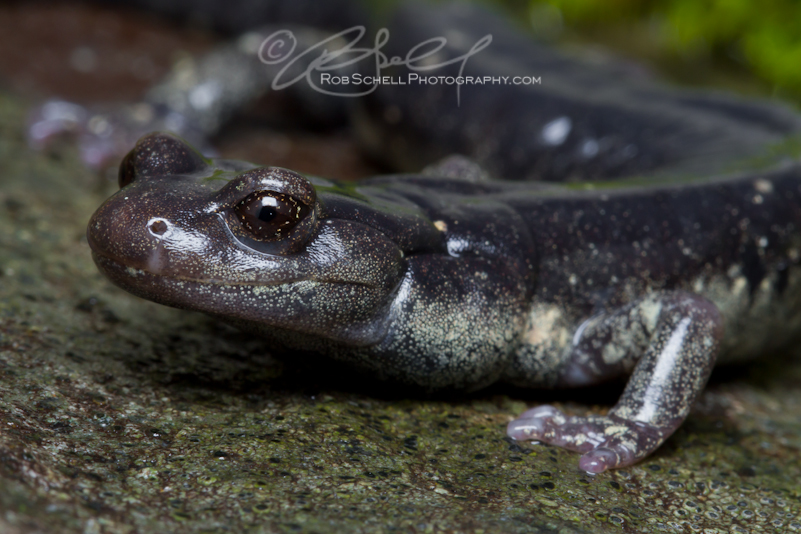
Black Salamander (Aneides flavipunctatus) by Rob Schell Photography, on Flickr
Father Aneides flavipunctatus flavipunctatus:
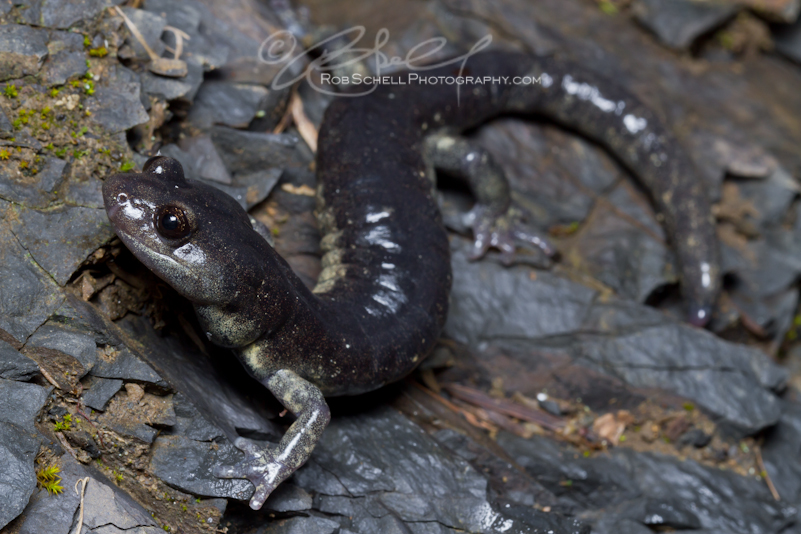
Black Salamander (Aneides flavipunctatus) by Rob Schell Photography, on Flickr
Baby Aneides flavipunctatus flavipunctatus:

Juvenile Black Salamander (Aneides flavipunctatus) by Rob Schell Photography, on Flickr

Juvenile Black Salamander (Aneides flavipunctatus) by Rob Schell Photography, on Flickr
Riding the success of the day, we packed up and headed inland - hoping to dominate the Aneides species. The next morning was cold and windy - not exactly the best salamander conditions, but you’re not going to find anything is you don’t look, so we grabbed some breakfast and headed out. We first stopped at a spot where I found Hydromantes a couple of months ago. At first glance, I was not optimistic. The moss had dried up, no surface water was to be found - our chances were surely bleak. I was happily wrong - within a couple minutes, I spotted a couple hanging out in the recesses of a small limestone cave.
Shasta Salamander (Hydromantes Shastae)
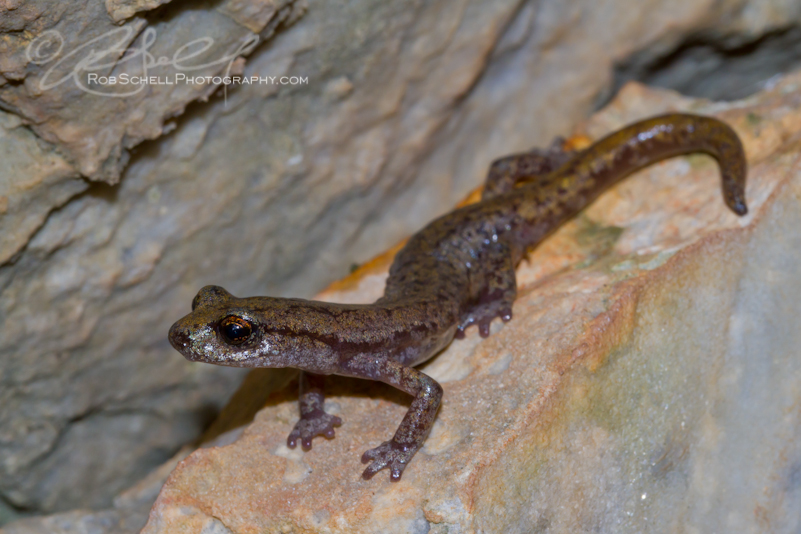
Shasta Salamander (Hydromantes shastae) by Rob Schell Photography, on Flickr
We were also able to flip a couple in the pursuit of our other target species. Regrettably, moisture conditions were just not conducive to finding Aneides iëcanus.
While stung a bit to end the trip on a miss, we did manage to find 11 distinct taxa of salamander across every genus that occurs in California. Sadly, without any more significant rain, I think this years’ Caudate activity in California is already on the decline. I didn’t post photos of the Taricha, Batrachoseps or Dicamptodon (larvae) that we found, but I still think by any standards, we did pretty well for a drought year.
For more of my photos and an archive of my trip accounts, please stop by my website at Rob Schell Photography | Wildlife and Nature Photography. You can also follow me on Facebook at Rob Schell Photography | Facebook.
Thanks for reading!
Cheers,
Rob
Traditionally, these trips have been less than focused. We would drive to areas, typically parks and the like, flip whatever and find little. This time was going to be different. I was tactical. I spoke to a number of people, sifted through databases, and most importantly received some very sage information from a former local, Michael Spencer. All of this led to the most successful amphibian trip I’ve ever taken.
On Friday morning, Brian and I met up at my office, loaded up my truck and hit the road. After a couple of short hours, we made it to southern Mendocino County. “Mendo” and I’ve come to refer to it, has always had a special place in my heart. Going back to 2003, I went on my first organized herping trip. Ever since, it has maintained mythical status in my physche. And on this day, It would pay dividends.
Our first spot was not what I would initially think of as diverse, but I was assured that this super-fantastic wonderland is awesome. On an otherwise dry stream-bank, some rock, a few boards and some AC yielded little. A little further closer to the stream on a slope with little shade, Brian flipped a long, thin board - under which was completely dry soil and a totally SICK adult spotted Black Salamander (Aneides flavipunctatus).
This is usually where I would put up two or three photos of this awesome animal, so what’s different in this case? Glad you asked.... As Brian was photographing the animal, a brief lunge sent it off the rock and down a hole where extraction was rendered impossible. I was really looking forward to photographing it also. Normally I’d be quite upset, however I was consoled by the fact that Brian was unable to get any decent shots of the animal either.
Besides, I was off finding a much cooler animal. A little further down the bank where a surface seep met the stream, I flipped a rock to find a uniquely colored and gorgeous frog.
Foothill Yellow-legged Frog (Rana boylii)

Foothill Yellow-legged Frog (Rana boylii) by Rob Schell Photography, on Flickr

Foothill yellow legged frog (Rana boylii) by Rob Schell Photography, on Flickr

Foothill yellow legged frog (Rana boylii) by Rob Schell Photography, on Flickr

Foothill yellow legged frog (Rana boylii) by Rob Schell Photography, on Flickr
We left this spot and proceeded down the road to a local watering hole to toast our good fortunes. This would surely be an epic trip.
We headed further west towards the coast - arriving in the late afternoon. We set out to increase our species count and because of a couple of hot-tips we’d received, we quickly would. Our first flip netted us four individuals of three species including the first of our target species. A bit more poking around netted us several more of the same species.
Wandering Salamander (Aneides vagrans)

Wandering Salamander (Aneides vagrans) by Rob Schell Photography, on Flickr
This subadult had an old, but significant dorsal scar. It has been suggested that it’s likely a combative scar from another individual Aneides - I tend to agree.
Additionally we found two Northwestern Salamanders:
Adult Ambystoma gracile

Northwestern Salamander (Ambystoma gracile) by Rob Schell Photography, on Flickr
Subadult Ambystoma gracile

Northwestern Salamander (Ambystoma gracile) by Rob Schell Photography, on Flickr
Lastly were one subadult and three adult Oregon Ensatina - we found about 25 more Ensatina on this day, but I only vouchered one - we had more important quarry to find.
Adult Ensatina eschscholtzii oregonensis

Oregon Ensatina (Ensatina eschscholtzii oregonensis) by Rob Schell Photography, on Flickr
After photographing these animals over the next hour or so, we set out to see what else we could find. A short time later we flipped a couple of juvenile Red-bellied Newts (Taricha rivularis). It seems like the defining characteristic of all Taricha species is their absolute and uncompromising ability to sit still. As such, I’ve completely lost my taste for spending any time to actually photograph these species beyond voucher shots - so I apologize to those newt-lovers among you - I won’t be posting any here.
As the sun began setting we hit the trail to scout a route for a night hike. We were of course compelled to flip along the way. Before the daylight gave out, we had one more species in the bag, literally. We bagged the critter to shoot the next day and headed off to dinner. We returned after dark and as the rain began to fall. We were hoping to hike down a Pacific Giant, or Northern Red-legged Frog, we even checked out a cascading stream for tailed frog, but after one, two, and three strikes, we were just two dudes out in the woods hiking in the rain. Little did I expect a home-run on the return trip.
We were getting close to the trail-head where we had flipped most of the cover earlier in the evening. We stopped to check out a downed redwood tree next to the trail which resulted in what was my favorite animal of trip. We bagged the animal to shoot it in more favorable light the next morning.
I apologize for so many photos of this individual, but it was one of the most fun photo shoots I’ve ever done. The animal was charismatic, and every pose was attractive through my lens. Moreover the animal itself, beyond being gorgeous, was totally chill, and whenever I’d pick it up it would use it’s prehensile tail to hold onto my finger. Every once in a rare while there are those shoots that everything comes together - this was one of those.
Wandering Salamander (Aneides vagrans)

Wandering Salamander (Aneides vagrans) by Rob Schell Photography, on Flickr

Wandering Salamander (Aneides vagrans) by Rob Schell Photography, on Flickr

Wandering Salamander (Aneides vagrans) by Rob Schell Photography, on Flickr

Wandering Salamander (Aneides vagrans) by Rob Schell Photography, on Flickr

Wandering Salamander (Aneides vagrans) by Rob Schell Photography, on Flickr
Since this post is as much about the photography as it is about the animals, I should go a bit into the gear. As some of you that follow my threads closely know, I have been trying out a new flash configuration. This was also the inaugural trip to try out some Graslon flash modifiers that were highly recommended by Owen Holt. Although they do a wonderful job of softening the light, they also take a lot of punch away from the flash. So I had to stop down both my shutter speed and up my ISO to 200 (something I usually hate doing) in order to get proper exposure. Even with all that, I still had to do some brightening in post. I suppose I probably did myself some disservice shooting this on the dark redwood bark, but under the canopy, the choices are rock, redwood, or moss.
Brian and I swapped animals and I took on the other find from the previous night. This critter was slightly less cooperative, but was compliant when it ultimately mattered.
Southern Torrent Salamander (Rhyacotriton variegatus)

Southern Torrent Salamander (Rhyacotriton variegatus) by Rob Schell Photography, on Flickr
This next shot, I set up for a long-exposure. I took several variations - some with fill flash, others without. Exposures from 1 second to 20. I think this one is the best compromise - a 6 second exposure with fill flash.

Rhyachotriton.variegatus.02 by Rob Schell Photography, on Flickr
Short of pulling a Pacific Giant or Tailed frog out of out hat, we decided to pack up and push further north. It took us most of the day to get up the very northwestern corner of the state. We stopped at one spot along the way and turned up a couple of solid animals, because of the dropping mercury, we bagged the animals and headed to the hotel. On the way, I found a unique rock, that I was able to procure for the photoshoot (I returned it once I was through). I mainly wanted to see how they would turn out - it’s definitely lends a different feel to the shots - for better or worse. What are your thoughts?
Painted Salamander (Ensatina eschscholtzii picta)

Painted Ensatina (Ensatina eschescholtzii picta) by Rob Schell Photography, on Flickr
Del Norte Salamander (Plethodon elongatus)

Del Norte Salamander (Plethodon elongatus) by Rob Schell Photography, on Flickr
The next morning, we returned our subjects and began to check out some habitat. A few miles up a logging road, we found some promising traits. We headed out and began flipping. After a short while, we came to a clearing, within that clearing, there were several downed redwood logs and logging spoils pile. Within several minutes, we managed to find another one of our targets. It was a large, and colorful individual, however it had a nipped tail that was beginning to regrow - which made it a bit odd to photograph. I didn’t spend quite so much time with this individual and regret it, but I managed to get a couple of shots that I’m quite happy with:
Clouded Salamander (Aneides ferreus)

Clouded Salamander (Aneides ferreus) by Rob Schell Photography, on Flickr
What do you guys think of this one? Does it work or miss the mark?

Clouded Salamander (Aneides ferreus) by Rob Schell Photography, on Flickr
At this location, we also flipped the most gorgeous Painted Salamander I’ve ever seen:
Ensatina eschscholtzii picta

Painted Ensatina (Ensatina eschescholtzii picta) by Rob Schell Photography, on Flickr

Painted Ensatina (Ensatina eschescholtzii picta) by Rob Schell Photography, on Flickr
With those two finds, we headed a bit further south, stopping at some drive-by sites to spot check for Black Salamanders.
We turned up a few more Torrent and juvenile Del Norte Salamanders, and even flipped this Subadult Northwestern under some leaf litter - that was pretty damn cool.
Ambystoma gracile

Northwestern Salamander (Ambystoma gracile) by Rob Schell Photography, on Flickr
The day was wearing on, so we stopped at one last place. Fortunately for us, that place was superbly productive. I flipped yet another juvie Del Norte Salamander - this was was another high-red colored individual, so I had to grab a couple of shots:

Del Norte Salamander (Plethodon elongatus) by Rob Schell Photography, on Flickr
While I was doing so, Brian flipped a very cool juvie Black Salamander - Just look at it!! It also meant we were in the right place. A short time later, Brian had an epic flip - undoubtedly the parents of said juvie. Adult male and female frosted phase Blacks. You can’t do any better than that!
Mother Aneides flavipunctatus flavipunctatus:

Adult, Black Salamander (Aneides flavipunctatus) by Rob Schell Photography, on Flickr

Black Salamander (Aneides flavipunctatus) by Rob Schell Photography, on Flickr
Father Aneides flavipunctatus flavipunctatus:

Black Salamander (Aneides flavipunctatus) by Rob Schell Photography, on Flickr
Baby Aneides flavipunctatus flavipunctatus:

Juvenile Black Salamander (Aneides flavipunctatus) by Rob Schell Photography, on Flickr

Juvenile Black Salamander (Aneides flavipunctatus) by Rob Schell Photography, on Flickr
Riding the success of the day, we packed up and headed inland - hoping to dominate the Aneides species. The next morning was cold and windy - not exactly the best salamander conditions, but you’re not going to find anything is you don’t look, so we grabbed some breakfast and headed out. We first stopped at a spot where I found Hydromantes a couple of months ago. At first glance, I was not optimistic. The moss had dried up, no surface water was to be found - our chances were surely bleak. I was happily wrong - within a couple minutes, I spotted a couple hanging out in the recesses of a small limestone cave.
Shasta Salamander (Hydromantes Shastae)

Shasta Salamander (Hydromantes shastae) by Rob Schell Photography, on Flickr
We were also able to flip a couple in the pursuit of our other target species. Regrettably, moisture conditions were just not conducive to finding Aneides iëcanus.
While stung a bit to end the trip on a miss, we did manage to find 11 distinct taxa of salamander across every genus that occurs in California. Sadly, without any more significant rain, I think this years’ Caudate activity in California is already on the decline. I didn’t post photos of the Taricha, Batrachoseps or Dicamptodon (larvae) that we found, but I still think by any standards, we did pretty well for a drought year.
For more of my photos and an archive of my trip accounts, please stop by my website at Rob Schell Photography | Wildlife and Nature Photography. You can also follow me on Facebook at Rob Schell Photography | Facebook.
Thanks for reading!
Cheers,
Rob
